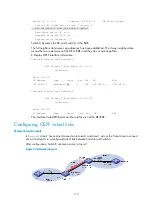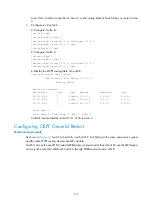
125
RelyNextHop: 0.0.0.0 Neighbor : 0.0.0.0
Tunnel ID: 0x0 Label: NULL
BKTunnel ID: 0x0 BKLabel: NULL
State: Active Adv Age: 00h58m10s
Tag: 0
The output shows that Switch A communicates with Switch B through VLAN-interface 11.
Troubleshooting OSPF configuration
No OSPF neighbor relationship established
Symptom
No OSPF neighbor relationship can be established.
Analysis
If the physical link and lower layer protocols work well, verify OSPF parameters configured on interfaces.
Two neighbors must have the same parameters, such as the area ID, network segment, and mask (a P2P
or virtual link may have different network segments and masks).
Solution
1.
Use the
display ospf peer
command to display OSPF neighbor information.
2.
Use the
display ospf interface
command to display OSPF interface information.
3.
Ping the neighbor router's IP address to verify connectivity.
4.
Verify OSPF timers. The dead interval on an interface must be at least four times the hello interval.
5.
Use the
peer ip-address
command to specify the neighbor manually on an NBMA network.
6.
On an NBMA or a broadcast network, at least one connected interface must have a router priority
higher than 0.
Incorrect routing information
Symptom
OSPF cannot find routes to other areas.
Analysis
The backbone area must maintain connectivity to all other areas. If a router connects to more than one
area, at least one area must be connected to the backbone. The backbone cannot be configured as a
stub area.
In a Stub area, all routers cannot receive external routes, and all interfaces connected to the stub area
must belong to the stub area.
Solution
1.
Use the
display ospf peer
command to display neighbors.
2.
Use the
display ospf interface
command to display OSPF interface information.
3.
Use the
display ospf lsdb
command to display the LSDB to verify its integrity.
















































